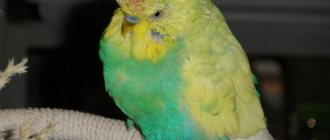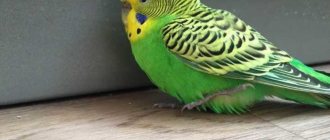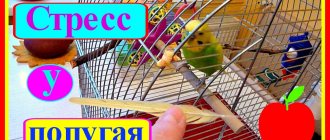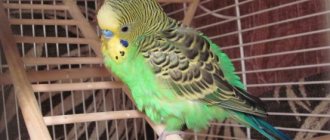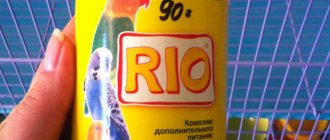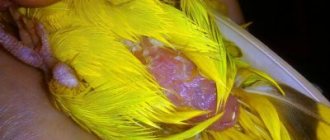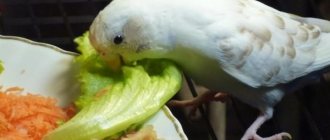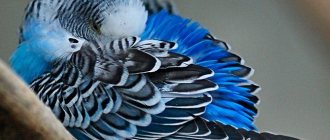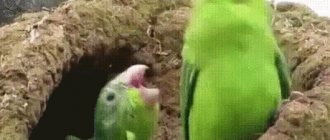The parrot is trembling or ruffled: what does this mean?
Do you notice that the bird is shaking and clucking, but you don’t know why? A parrot's body trembling may mean that your pet is sick, scared, or in discomfort. Everything can be simple or very complicated, but this fact certainly cannot be ignored. If you get yourself a parrot, you must take care of it and protect it from various dangers.
Experienced bird owners have probably more than once encountered the problem when the bird trembles, puffs itself, and often closes its eyes. Behavior that is uncharacteristic for a pet is the first warning signal for the owner that urgent action needs to be taken. Sometimes it’s enough just to warm up the bird, and sometimes you need to quickly go to the doctor. First, you should take a close look at the bird to understand why it is ruffled, and only then draw conclusions regarding its condition.
Symptoms of tachycardia in children
Symptoms and their intensity vary depending on the type of disease and its duration.
Main manifestations:
- vague discomfort in the heart area;
- feeling of heartbeat, heartbeat in the ears;
- lack of air, shortness of breath;
- pallor or blue discoloration of the skin and mucous membranes (in severe cases);
- weakness, fatigue, sluggish sucking in newborns;
- nausea due to dizziness;
- crying, anxiety;
- emotional arousal;
- faintness, loss of consciousness;
- sweating
Causes of trembling
The main reasons for this behavior:
- Hypothermia. Perhaps you placed the cage in a draft or simply forgot to close the window? If the room is cool, and the parrot’s wings are trembling, then he is simply cold. Why don't his wings protect him from freezing? Although plumage is a protective barrier from the environment, it cannot completely protect the bird’s skin from all adverse effects.
- Fear or stress. Any animal that lives in your home can scare the bird with a sudden movement or sound. Do you have children? Why don't you ask if they scared the parrot? If the pet is very frightened, it will tremble and cackle. The same thing happens with stress. Changing your place of residence or introducing a new bird can be a shock for your pet.
- Disease. If your budgerigar is trembling and ruffled, and besides, you notice other symptoms, then most likely the bird is sick. The bird may sneeze, close its eyes, its droppings will be liquid, and its crop will be filled with vomit. Signs of the disease can occur in a complex or individually. Any of them is a reason to see a doctor.
- Avitaminosis. If there is a lack of vitamins, any parrot will crest, tremble and bristle its tail. This happens when the bird’s diet is too monotonous and poor in useful components.
If your parrot is ruffled, trembles a little, appears drowsy (closes his eyes more often and sleeps), cannot poop, but has a good appetite. In this case, you should show the bird to a doctor, since these symptoms may indicate various pathologies.
In the video, the parrot's wings are shaking.
When to see a doctor
There are certain symptoms that you should immediately contact your veterinarian for:
- fracture of limbs, tail or wing;
- the appearance of a bleeding wound on the body;
- signs of poisoning and digestive disorders;
- apathy, drowsiness;
- itching of the skin, excessive loss of feathers;
- partial or complete refusal to eat;
- convulsions in a budgie;
- uncharacteristic cry, wheezing.
In the situations described above, it is better to consult a specialist for a diagnosis. You may certainly not know what causes this or that symptom, but the doctor will quickly determine the cause of this condition and alleviate it as soon as possible.
What symptoms should you be concerned about?
If the only change in your parrot's behavior is trembling, then there is nothing to worry about. But adding other signals is a reason to contact a veterinarian.
- The cockatiel is restless, spinning around the cage and screaming;
- The timbre of the voice changed, wheezing and uterine sounds appeared;
- Motor coordination is impaired;
- Rolling eyes;
- The bird does not respond to external stimuli;
- Clear traces of moonshine are visible, feathers all around;
- The skin is scratched until it bleeds;
- The parrot will not touch the food.
When poisoned, the rooster suffers from diarrhea, as well as vomiting and trembling. Particularly severe conditions are characterized by difficulty breathing and even convulsions.
Adaptation of a bird to a new home
When changing a cage or moving to a new home, a parrot may feel not just discomfort, but even severe stress. You will notice that he is cackling and shaking, but you will not understand why. If you have recently moved or bought a new cage, then you will just need to wait until the bird gets used to it, carefully examining its home with its eyes.
Sorry, there are no surveys available at this time.
Talk to him, monitor his behavior and do not let him out for several days. Let the baby get used to the new home, look around, notice all the toys. It happens that the bird gets ruffled and looks irritated and constantly angrily rushes at some object. To calm your pet, simply remove the irritant from the cage.
Symptoms of neurosis
Pathology manifests itself both at the physical and psycho-emotional levels. Physical symptoms include increased sweating, rapid heartbeat, chest pain and dry mouth, headaches, blurred vision, tremors of the limbs, skin rashes, and menstrual irregularities in women.
Psychological symptoms: a feeling of loss of control, a feeling that the person is “going crazy”, fear of sudden death, excessive worry, high sensitivity and vulnerability.
- Irritability;
- Constant feeling of fatigue and apathy;
- Increased sensitivity;
- Social isolation;
- Frequent and unexpected mood swings;
- Disturbances in sleep and wakefulness;
- Loss of interest in life or certain areas of it.
It is the constant feeling of anxiety for one’s life or the lives of loved ones that causes insomnia in a person. Problems with sleep do not allow the body and nervous system of those suffering from neurasthenia to fully rest. This, in turn, further intensifies all the symptoms listed above.
Therefore, for insomnia, experts recommend several simple and effective rules:
- Follow a daily routine, that is, try to fall asleep and wake up at the same time;
- Play sports, giving the body a light load;
- Be in the fresh air more often;
- Reduce the number of drinks containing caffeine;
- Eat light foods to avoid stomach discomfort.
For what reasons does neurosis develop?
- Strong mental activity;
- Prolonged psychological distress and anxiety;
- Psychological pressure due to the inability to solve life problems;
- Long-term loneliness and problems in the personal sphere of life;
- Traumatic event in life: loss of a loved one, difficult divorce, difficult financial situation, if the person has been subjected to emotional and physical abuse, etc.;
- High expectations. In this case, the person cannot achieve the desired goal and experiences a feeling of an impossible plan;
- Psychological trauma received in childhood: humiliation or beating from peers and parents, example of a bad lifestyle from adults, harsh upbringing;
- Failure to comply with work and rest schedules.
First aid for illness and injury
If you notice symptoms of illness in your parrot or see that the bird has been injured, give your pet first aid before visiting a doctor. You shouldn’t treat your bird yourself if you don’t know for sure how to do it! Just provide your pet with care and minimal pain.
In case of hypothermia, cover the cage with a thick cloth, leaving a gap in front. You can also direct the light from the lamp onto the pallet. If you experience shortness of breath, the lamp should be removed.
If the parrot is shaking, tufting, spreading its legs, limping, or protruding its wing or tail unnaturally, then the bird may have a fracture. Carefully pick up the bird and transport it to the hospital as soon as possible.
The wound can be treated with hydrogen peroxide, but under no circumstances should you use alcohol, brilliant green and iodine, as these compounds can cause a burn to the bird. In some cases, wrapping the bird or placing it in a box with soft flooring helps (especially effective for convulsions).
Treatment of a feathered friend
Unless you are a veterinarian, it is best not to treat your bird yourself. In case of simple hypothermia, colds, poisoning, stress or even inflammation of the eyes, you can correct the situation at home. But in case of animal bites, fractures of the tail, wing, paw, dislocations, inflammations of various types, or the presence of infections, you need to contact a specialist as soon as possible, otherwise the outcome may be fatal.
What does tachycardia mean in a child?
Pediatric cardiologists consider it a disease when the number of heart beats per minute exceeds the norm by 20-30.
On a note! An impulse originates in the sinus node in the right atrium, which spreads to the atria and causes them to contract. The impulse is briefly delayed in the atrioventricular node between the ventricles and atria and transmitted to the ventricles, causing them to contract. The sinus node independently creates impulses within itself at a certain frequency. This is called "sinus rhythm."
Tachycardia is not an independent disease, but a sign of some other pathology. However, there is physiological tachycardia, which occurs during physical activity, emotional arousal, during eating, and when body temperature rises. This condition is completely harmless and does not threaten the child’s life. Tachycardia can occur even in a newborn child if he laughs, tries to make movements that are new to him, etc.
Prevention of diseases and stress
In order for your parrot to feel comfortable and not get sick, it is necessary to provide it with appropriate conditions in the cage. Arrange the bird's house so that it feels comfortable there. The cage itself and the perches must be made of natural and high-quality materials.
An important component of good care is proper nutrition of the bird. Feed only proven ingredients, not forgetting about vitamins. Avoid obesity or exhaustion of the body. If your pet closes its eyes, tucks its tail, cackles, and is exhausted, then you should think about force-feeding with a syringe or pipette.
It should also be remembered that parrots are susceptible to airborne viral diseases. If you have a cold, then temporarily limit your communication with birds. Well, if you basically don’t know what to do, but notice strange symptoms in your pet, then just seek help from a doctor.
Several signs that should alert a breeder
Parrots are very active and inquisitive, especially when flying around the room. If you let him out of your attention even for a few minutes, he will probably have time to crash. And the likely outcome is a fracture, which is indicated by lameness, the pet twitches its wings and tries not to move. You need to put him in a carrier and go to the veterinary clinic.
They can become infected with viral diseases from the owner, then they tremble and refuse to eat. During your own illness, it is better to wear a gauze bandage in the room with the parrot's cage. If a female parrot's tail is shaking, or rather, oscillating like a pendulum, this may indicate the imminent appearance of offspring. During this period, parrots need to be provided with comfortable conditions and closely monitor the condition of the female.
Video “Diseases of parrots. Symptoms and treatment"
This video talks about why parrots get sick, how to diagnose the disease and cure it.
Was this article helpful?
Thank you for your opinion!
The article was useful. Please share the information with your friends.
Yes (100.00%)
No
X
Please write what is wrong and leave recommendations on the article
Cancel reply
Rate the benefit of the article: Rate the author ( 8 votes, average: 4.75 out of 5)
Discuss the article:
Diagnostic methods
- Electrocardiography (ECG). After examining the printout, the doctor will be able to determine the type of tachycardia and see, for example, heart failure.
- Daily Holter monitoring is intended to detect paroxysmal tachycardia. Electrodes are attached to the baby's skin and connected to a compact device that takes readings around the clock. Sometimes it takes more than a day.
- Ultrasound of the heart (Echo-CG) - allows you to see the structure of the heart, structural abnormalities, visualize large vessels and heart valves and chambers, the thickness of the walls of the organ, and evaluate its contractile function. Ultrasound allows you to see heart defects.
- A clinical blood test aimed at detecting anemia. With it, a compensatory acceleration of heart rate occurs.
- Biochemical blood test for glucose levels and electrolyte composition.
- Blood test for thyroid hormones.
- Electroencephalography (EEG).
- MRI of the heart - in rare cases.
- Electrophysiological study (EPS) of the heart is necessary to evaluate electrical activity and find the source of impulses in the paroxysmal type of tachycardia.
What to do if a child has an attack of tachycardia before the doctors arrive?
Until the ambulance arrives, there are several ways to alleviate the child’s condition:
The most important thing is to calm the child down, open a window or vent so that fresh air can enter the room. The following measures can then be taken:
- Wipe the child's face with cold water, and then place a cloth soaked in cold water on his face.
- Have your child close his eyes and then gently apply pressure to his eyeballs for a few seconds. This will provoke a reflex in which the heart rate decreases.
- Perform a Valsalva maneuver - the child should close his mouth and nose tightly and strain as if he wants to exhale.
- Massage the carotid sinus, that is, the place where the carotid artery divides into two branches - external and internal. This place is located approximately where the thyroid cartilage is on both sides of the neck. It’s easy to feel the thyroid cartilage; in men it’s called the “Adam’s apple.” After this, move your fingers slightly downward, and immediately under the Adam’s apple you will feel the carotid sinus with a characteristic pulsation. Apply pressure and massage for a few minutes. Source: L.A. Balykova, I.S. Nazarova, A.N. Silence Treatment of cardiac arrhythmias in children // Practical Medicine, September 2011, No. (53), pp. 30-37
Prices
| Name of service (price list incomplete) | Price |
| Appointment (examination, consultation) with a cardiologist, primary, therapeutic and diagnostic, outpatient | 1750 rub. |
| Prescription of treatment regimen (for up to 1 month) | 1800 rub. |
| Consultation (interpretation) with analyzes from third parties | 2250 rub. |
| Consultation with a candidate of medical sciences | 2500 rub. |
| Electrocardiography (ECG) | 1400 rub. |
| Echocardiography (ultrasound of the heart) | 3500 rub. |
